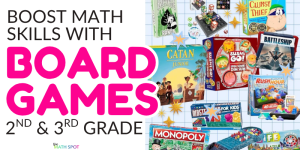
Naming Fractions Interactive Notebook Strategy
Much of learning to name fractions in third grade is an exercise in understanding and applying new vocabulary terms. In second grade when students were laying the foundation for fraction work students used words such as half, quarter and whole. Teachers may have talked about parts or pieces but they most likely weren’t using words such as numerator and denominator at that point in time.
It can be so helpful at the beginning of a new unit on fractions to be sure to teach and practice vocabulary in a systematic way to help prevent misconceptions and misunderstandings! Let’s look at the word denominator as an example. Understanding the denominator of a fraction is not difficult. If you look at a whole broken into 6 pieces you know you are working with sixths and the denominator of the fraction is 6. This is really just an exercise in counting! There is no earth-shattering, difficult to learn math here. But, the word denominator is definitely new to our students and so they need time and room to practice the new concept of identifying and understanding the denominator while applying the vocabulary of “denominator”.
When our students are really very comfortable with these new fraction vocabulary words they will be able to free up the mental space to think about the new understandings that come along with fractions. Hands-on experiences will be more rich when our students are ready to explore and apply their understandings around these new vocabulary words. Am I saying that you need to teach the vocabulary before you can allow your students to explore fractions?
ABSOLUTELY NOT!! What I am advocating for is that once students have had instruction around vocabulary you are sure to give students opportunities to use their new vocabulary to describe what is happening with fractions even if the concepts themselves seem simple.
So how might this play out in the classroom?
- Day 1: Your students do an activity where they are looking at pizzas that have been cut into equal pieces. You have each pizza labeled with a unit fraction describing one piece of pizza. Students are doing a notice and wonder activity around what they see in the pizzas and what they see in the labels on the pieces of pizza.
- Day 2: Yesterday, your students noticed that the bottom number of the fractions match the number of pieces of pizza. You tell your students that their observation was spot on and that we have a math word for this- denominator! Next, give some explicit practice of this concept! Look at these different pictures, what would the denominator be on each of these fractions? Practicing math concepts is not a bad thing. Every single math lesson you teach does not need to be a hands on discovery lesson- sometimes, after building an initial understanding you just need to practice!
- Day 3: Your students have been working with the word denominator so you want to give them a new experience that will allow them to apply their new vocabulary word. Maybe you do an activity with a pan of brownies. You tell an elaborate story about how at first you baked these brownies to share with just 4 friends but, as more friends showed up to your party, you had to cut them into more and more equal pieces. As you work through the story, ask your students what is happening to the denominator of the fraction. Ask if they could write fractions recording the denominator as more and more friends show up. Expect your students to use this word, a lot!
Related Resources:

Pin For Later:




